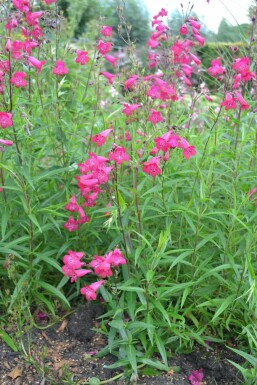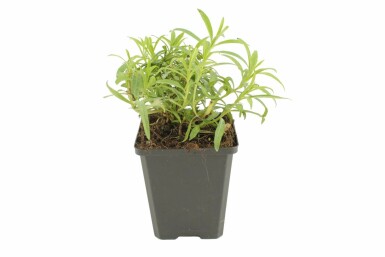

60cm




Updated on 10 September 2025
We regret to inform you that we are currently unable to ship orders to the United Kingdom. We anticipate being able to resume shipments at the beginning of 2026.
Penstemon thrives in sunny borders, adding vibrant colour with its trumpet-shaped flowers. Its long flowering period attracts bees and butterflies, making it ideal for ecological gardens. Suitable for pots, planters, and group plantings, it grows quickly, transforming gardens beautifully.


60cm




Penstemon is a striking addition to any garden, known for its long blooming period from June to August. This upright perennial features lanceolate leaves and vibrant tubular flowers that come in shades of red, purple, and blue. Adding Penstemon to sunny borders or cottage gardens will enhance colour throughout the summer. Its colourful blooms also attract bees, making it perfect for bee gardens. Curiosity peeks—what makes Penstemon a favourite among gardeners? Discover why this long-flowering border plant stands out. For those interested, options to buy Penstemon plugs in the UK are readily available, promising a lively garden display. Embrace the vibrant presence of beard tongue for a garden transformation with minimal effort.
Penstemon, also known as beardtongue, is a perennial plant with tubular flowers. It’s popular in gardens for its long blooming period and tall, spire-like form. Often called summer spire or cottage border staple, this plant adds height and colour to borders and group plantings. Beardtongue belongs to the Plantaginaceae family and is native to North America, where it thrives in various climates. In natural habitats, its tubular flowers attract bees, bumblebees, and butterflies, playing an important ecological role. The name Penstemon comes from the Greek words pente (five) and stemon (stamen), reflecting its unique flower structure. Indigenous cultures regard it as a symbol of healing and steadfastness. As a drought-tolerant plant, Penstemon prefers well-drained, sunny locations and is known for fast growth. Its lifecycle is perennial but short-lived, making it a suitable choice for natural gardens or insect corners. Consider using it alongside other cottage garden perennials for a robust display. For those looking to enhance their garden, buy Penstemon plugs UK to enjoy this beautiful and hardy plant.
The Penstemon is a long-flowering perennial with bell-shaped flowers. This plant thrives in well-drained, sunny locations, showcasing bushy, upright growth that makes it ideal for borders and natural gardens. Penstemon grows quickly and can reach heights between 30 cm and 120 cm, depending on the variety. It is drought-tolerant and enjoys full sun exposure for optimal development. From the budding stage, Penstemon develops tubular flowers that are a favourite among pollinators, especially bees. The blooming period stretches from June to September, influenced by factors like climate, soil quality, and care. Its vibrant flowers come in an array of colours, including purple, pink, and red, which can vary based on the species and environmental conditions. While not typically known for fragrance, the Penstemon's appeal lies in its striking blooms and crucial role in supporting biodiversity. Regular deadheading and cutting back are recommended to encourage continuous flowering and maintain plant health. For gardeners, this plant's resilience against drought and its fast-growing nature make it an excellent choice for adding long-lasting colour and life to any garden setting.
Penstemon has elongated, lanceolate leaves that often sit oppositely on the stem. The colour ranges from fresh green to dark green, adapting well to different environments. In winter, this plant may lose its foliage, especially if exposed to wet conditions. Its winter hardiness varies between USDA zones 6 to 8, with temperatures down to -18°C. Proper drainage is key to protect against frost damage. In spring, pruning helps promote healthy growth. Penstemon is generally semi-hardy, tolerating heat and wind well, but it’s sensitive to prolonged wet winters. Hence, positioning in well-drained soil with some shelter from excessive rain is recommended. This plant is not toxic, making it safe for children and pets, and it adds beauty to flower beds with its trumpet-shaped flowers that bloom from June to October. Penstemon attracts bees and bumblebees, supporting biodiversity in the garden. It thrives best in well-drained soils, mimicking its natural habitat. While it’s resilient to heat, adequate watering during dry spells is beneficial. Deep roots help it endure drought, but avoid overwatering. Using it in the garden enhances ecosystem balance by providing food and shelter for insects. For those looking to grow Penstemon 'Raven' in the UK, overwintering advice involves ensuring soil drainage and spring pruning for optimal growth. This plant is a staple in cottage borders, enhancing the garden with vibrant colours and ecological benefits.
Penstemon, known for its vibrant tubular flowers, is a favourite choice for adding colour to a variety of garden styles. Its long blooming period makes it an attractive option for gardeners looking to enhance their outdoor spaces. Here are some specific ways to incorporate Penstemon in the garden:
Penstemon can create stunning combinations in the garden when paired with other perennials. In sunny borders, the vibrant flowers of Penstemon stand out beautifully alongside Salvia and Achillea. These plants share similar growing conditions and complement each other well. Gaura and Nepeta add movement and contrast to a Penstemon border, with their delicate flowers swaying in the breeze. Lavandula brings fragrance and a lovely colour contrast, making the combination visually appealing. Coreopsis adds a splash of bright colour, enhancing the cheerful display of Penstemon blooms. Achillea, with its flat-topped flowers, offers an excellent backdrop to the spires of Penstemon. This mix is perfect for a bee garden, as all these plants are excellent bee attractors. Penstemon blooms for a long time and attracts bees among airy prairie plants. This captivating combination not only creates a beautiful scene but also supports garden biodiversity.
Penstemon thrives in full sun, needing at least 6 hours of sunlight each day. This ensures vibrant growth and blooming. Light exposure affects its health, so place it in well-drained, moderately moist soil for best results. Although semi-hardy, Penstemon is wind-tolerant. However, using windbreaks such as hedges can reduce the impact during harsh conditions. The ideal soil for Penstemon is low-lime and well-drained. A sunny, sheltered site helps enhance its growth. Regular feeding and maintaining a well-draining substrate are crucial for its development. Wind, sun, and soil type affect the moisture levels in the ground. Ensure the soil stays moist but not waterlogged, as Penstemon is sensitive to wet winters. Penstemon prefers slightly acidic to neutral pH levels. Factors like soil composition and water quality influence its health. Keeping these conditions balanced encourages vibrant blooms and a thriving garden presence. Whether part of a cottage garden or as a focal feature, Penstemon, also known as beardtongue or summer spire, is a stunning cottage border staple.
Penstemon is best planted in spring, around May to June, when the weather is warm and stable. Plants in pots can be planted year-round, except during frost. Bare-root or root-balled plants should be planted in spring or autumn. The planting distance for Penstemon depends on the plant type, size, growth rate, and number per metre. Information about planting density is usually listed on the plant's properties page. To prepare the ground for Penstemon, use dry, well-draining soil that is only lightly fertile. Heijnen's planting soil is recommended for the best results. Penstemon should be planted in full sun, in at least 6 hours of sunlight per day, and requires well-drained, moderately moist soil. Avoid wet, heavy soils. To plant Penstemon, dig a hole twice as wide as the root ball, and mix in Heijnen planting soil. Water them well after planting and regularly during dry periods. To ensure healthy growth, rejuvenate by removing old flower stems. Penstemon is semi-hardy, tolerates heat, and has some resistance to wind but is sensitive to wet winters. This perennial is a long-flowering border plant and attracts bees, making it an excellent addition to any garden.
Penstemon, also known as beardtongue, is a beautiful addition to any garden. To keep penstemon healthy and blooming from June to October, some care and attention are needed. Below are some tips to ensure the plant stays vibrant and continues to attract bees, bumblebees, and butterflies.
For those looking to add more life to their garden, consider a group planting of the summer spire or use it as a cottage border staple. Remember, buying beardtongue can be a great choice for a natural garden and insect corner.
Penstemon is known for its vibrant, trumpet-shaped flowers that bring life to any garden. These flowers, which can be found in shades of purple, pink, white, red, blue-purple, and lavender, attract bees and bumblebees, making them a favourite in bee-friendly gardens. As a colourful bee plant with trumpet-shaped flowers, Penstemon plays a vital role in supporting pollinators. The fresh to dark green leaves of Penstemon add a lush backdrop, enhancing the flowers' colours. Beard tongue grows as a bushy, upright perennial, often with a branched growth pattern, providing structure and height to garden borders. This fast-growing, drought-tolerant plant is perfect for sunny borders and cottage gardens, offering a long flowering period that lasts from early summer to autumn. The plant's tubular flower shape not only makes it visually appealing but also a practical sanctuary for insects seeking shelter or food. As a long-flowering border plant, Penstemon is a valuable addition to any garden, combining beauty with ecological benefits.
Penstemons, or beardtongues, are popular perennials known for their tubular flowers and long blooming period from June to October. These plants are perfect for adding vibrant colours and interesting shapes to any garden. Many gardeners appreciate them for their ability to attract pollinators and their ease of care.
Penstemon is a popular plant for gardens due to its vibrant appearance and ease of growth. Here are some advantages and disadvantages of growing Penstemon:
Advantages:
Disadvantages:
Proper soil preparation, choosing the right location, and regular care can reduce the risk of diseases and pests. It's essential to care for plants well to ensure the best growth and blooming potential of Penstemon (beardtongue).
Penstemon is a wonderful addition to any garden. Known for its vibrant colours, this sun-loving plant is perfect for cottage gardens, bee gardens, or sunny borders. When considering a purchase, Heijnen offers a stunning selection of Penstemon that will enhance any outdoor space. The biggest advantage of Penstemon is its long flowering period from June to October. Penstemon, also known as beardtongue, attracts bees and butterflies, making gardens lively and buzzing with life. It's excellent for borders and pots, adding instant colour and growth. For garden maintenance, keep Penstemon thriving by deadheading spent blooms and providing frost protection in colder months. Cutting back in late autumn promotes healthy growth for the next season. To enjoy colourful blooms and a vibrant garden all summer, order Penstemon from Heijnen. Experience the joy of tubular flowers that will attract beautiful butterflies to your garden.
We would like to provide some tips on how to plant and care for a Penstemon. By following these tips, you can be sure to enjoy your Penstemon for a long time.
Penstemon thrives best in a sunny and sheltered location. It requires at least six hours of full sun per day. The plant prefers low-lime, well-drained soil that is moderately moist. A good site is crucial as it promotes better growth, richer blooms, and a healthier plant overall. This positioning ensures Penstemon has better resistance and more vibrant leaf colours. It grows well in sandy, loamy, or gravelly soils, as these allow for excellent drainage. While semi-hardy, Penstemon is sensitive to wet winters, so it's best to avoid overly damp spots. Use it in sunny borders, cottage gardens, or bee gardens, and it can be planted in pots or planters for versatility. The right location is essential for the successful growth and flowering of Penstemon. Regular pruning encourages bushy development and maintains its attractive appearance.
Soil preparation is key when planting Penstemon, a lovely perennial known for attracting bees. Start by ensuring the soil is well-drained and lightly fertile. This is vital for healthy plant growth, as good soil preparation ensures water drains away easily, preventing root rot. Adding organic materials like compost or Heijnen planting soil can enhance soil quality, providing ample nutrients. Pot-grown Penstemon can be planted year-round, avoiding frost periods, while root-balled plants are best planted in spring or autumn. After planting, water the plants thoroughly until they are well-rooted. The size of each plant will determine how many you can fit in a square metre. Remember, proper preparation and care lead to flourishing Penstemon, creating a vibrant garden display. Beardtongue, as it's also called, thrives in full sun, so choose a sunny, sheltered spot to enhance growth.
Penstemon benefits greatly from timely fertilisation. Proper feeding ensures healthy growth and vibrant blooms. Vitality is enhanced, leading to robust plants with stunning flowers. Using organic fertilisers like those from Heijnen is crucial. These enrich the soil with essential nutrients, promoting good growth and the overall health of Penstemon plants. Apply fertiliser twice yearly; once in spring to support new growth and again in summer to maintain flower production. The amount depends on plant size, ensuring not to overfeed. Begin with a cautious amount and adjust as necessary. Fertiliser is activated when watered, so if there's a dry spell, manually water the garden to help nutrients reach the roots. This ensures that beardtongue remains a striking feature in any garden setting, whether in borders, planters, or natural gardens, with colours ranging from purple to red.
Penstemon is a striking plant often found in gardens. It should be pruned after it has finished blooming. This encourages it to produce new flowers. Additionally, pruning in spring helps remove any dead branches, keeping the plant healthy. Regular pruning has several benefits. It maintains the shape of the plant, encourages growth, and ensures an abundance of flowers. Pruning is best done twice a year, in early spring and after the flowering period has ended. Sharp secateurs are essential for this task. They ensure clean cuts which help the plant to heal faster. Quality tools make the process easier and protect the plant from damage. For best results, always cut back Penstemon after blooming and again in spring. This routine encourages reblooming and maintains its vibrant presence in the garden.
Penstemon plants have a moderate need for water. It's crucial to water newly planted Penstemons regularly to help them establish roots. Once these plants are established, they only require watering during prolonged dry spells. When watering Penstemon, it's better to give them a generous amount of water once rather than a little every day. Early morning or late afternoon is the best time for watering, as it reduces evaporation. Checking the soil before watering ensures whether the plant truly needs it, as excess water should always drain away. This applies to both Penstemon in the ground and in pots. Drip irrigation systems are effective once the Penstemon has rooted well, but initially, manual watering is necessary. While Penstemon is moderately drought-tolerant, extended drought periods can reduce flowering. Ensuring proper water management helps maintain healthy growth for these beautiful plants.
Penstemon is a charming addition to any garden, known for its trumpet-shaped flowers that come in many rich colours. These blooms attract bees and bumblebees, making it a favourite for those wanting to support local wildlife. It's not toxic to children or pets, so it's safe for family gardens. Penstemon is also appreciated for its long flowering period and versatility, thriving in both borders and pots. Additionally, this plant, sometimes called beardtongue, grows quickly and adds vibrant colour to its surroundings.
Penstemon can be a wonderful addition to any garden. Dividing the plant helps rejuvenate it, promoting healthier and more vigorous growth. It also allows for the removal of older, less productive parts, ensuring the plant remains vibrant. By sharing the plant, gardeners can easily multiply their collection, enhancing the garden's diversity. Carefully dig up the plant, remove old sections, and replant the young parts. This should be done every three to four years, preferably in autumn. A spade or garden fork is ideal for this task. Division in spring is also suitable for perennials like beardtongue. Ensuring correct timing and tools is essential for successful plant division.
The beardtongue is a stunning perennial with tubular flowers in vibrant colours like purple, pink, and red. It blooms from June to August, offering a long flowering period that is perfect for attracting bees and butterflies. Ideal for sunny borders and garden pots, this fast-growing plant adds both beauty and ecological value. Order Penstemon (Beardtongue) from Heijnen and enjoy its delightful presence all summer.
